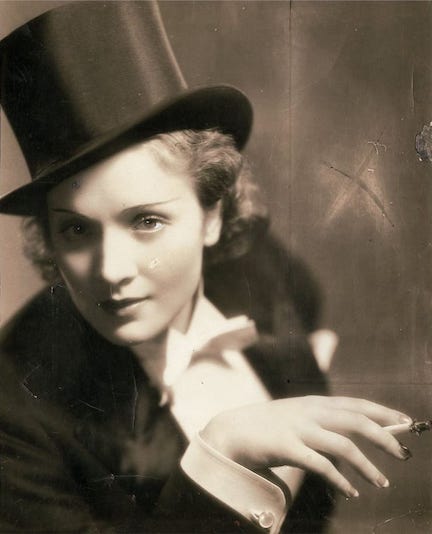Janelle Monáe and the History of Androgynous Queer Fashion Icons

In episode 5 of the recently-released third season of Queer Eye on Netflix, entitled “Black Girl Magic,” the Fab Five are helping out a young black lesbian named Jess. Tan (the fashion expert) and Jess are discussing her style choices when Jess mentions that Janelle Monáe is her style icon much to Tan’s evident delight.
Jess’s idolization of Monáe (and Tan’s excitement at just hearing her name) is understandable. Though Monáe’s mainstream recognition started relatively recently, her style choices have attracted attention since she received her first Grammy nomination back in 2009. While she has branched out in the last couple of years, Monáe’s signature style is a simple black and white tuxedo. Although Monáe didn’t publicly come out until 2018, she had been known and celebrated as a queer fashion icon for years before that. Indeed, Autostraddle (an online magazine aimed at queer women) was recognizing Monáe as a queer fashion icon and discussing how to 'steal her style' as early as 2012, 6 years before her coming out.

What, however, makes for a “queer fashion icon?” Well, beyond the fact that many identify somewhere on the LGBTQ+ spectrum, it takes only a cursory glance over queer fashion icons of the past to recognize the commonality. Men who became queer style icons like David Bowie and Prince were known and celebrated by the queer community due to their feminine presentation - wearing makeup, bright flamboyant colors, even dresses at time. Women who become known as queer style icons such as Grace Jones and Monáe herself are generally known for their menswear. Androgyny is the name of the game when it comes to queer fashion icons - unsurprisingly, perhaps, as challenging the rigidity of gender binaries is an idea that is inherent in most queer communities.
Monáe is the most recent in a line of women who embrace androgyny and androgynous style by wearing suits, a line that can be traced back to Marlene Dietrich and Greta Garbo, movie stars of the 20s and 30s who are still well-known as style icons in queer circles today due to their daring to wear men’s clothing in a time where gender binaries were much more strictly enforced than they are today. Designer Yves Saint Laurent also contributed to this particular androgynous style choice early on with his 1966 introduction of “Le Smoking,” a tuxedo tailored for women, which remained controversial for some time after its debut.

Dietrich, who Monáe cites as one of her style inspirations, was herself bisexual, and pushed boundaries in her day by attending film premieres wearing a tuxedo, and famously kissing another woman in the film Morocco (yes, while wearing a suit). Her own attitude about her style choices were rather laid back – a 2017 article from Vogue about androgynous fashion icons quotes Dietrich as saying, "I am sincere in my preference for my men's clothes – I do not wear them to be sensational. I think I am much more alluring in these clothes."
Monáe also lists other aforementioned queer fashion icons as her own personal inspirations, such as Grace Jones and Prince - in fact, she had a close personal relationship with Prince, who assisted her on a song from her latest album, “Dirty Computer,” and who she considered a mentor, suggesting that she may have been directly influenced by the late icon’s androgyny.
Monáe is, however, unique from many of these past queer fashion icons who inspired her, in that she is a queer black woman. Even Grace Jones, while doubtlessly revered in queer communities is straight, thus making Monáe an outlier. As such, while she does serve as inspiration for queer people or queer women in general, her public style and presence is especially meaningful for younger generations of queer black women such as Jess from Queer Eye. The fact that she has fully embraced queer themes in her most recent works (see, for example, the music videos for her songs “Make Me Feel” and “Pynk”) is just the cherry on top, elevating her from a queer fashion icon to arguably a queer icon, period.
From Marlene Dietrich, to David Bowie, to Grace Jones, to Prince, to Janelle Monáe, the history of queer fashion icons has been overwhelmingly a history of androgyny. It points to the ridiculousness of strictly gendered clothing and also inspires young queer people to step out of the boxes society assigned to them. Janelle Monáe, along with many others who are known as queer fashion icons, are best summed up by the famous Prince quote from his song “I Would Die 4 U” (which, incidentally, Monáe quotes in her bio on her official Instagram): “I am not a woman. I am not a man. I am something you’ll never understand.”





